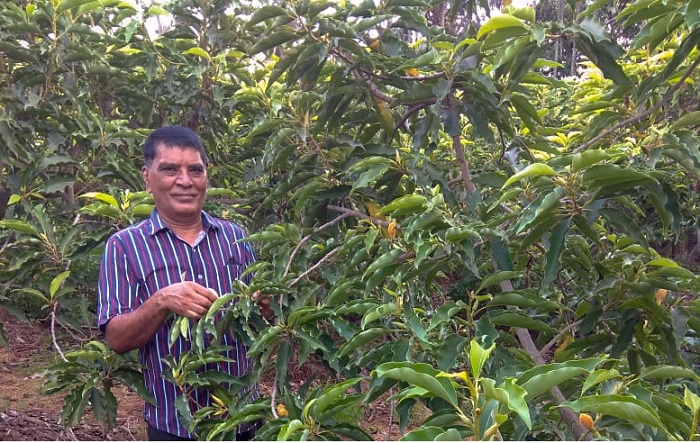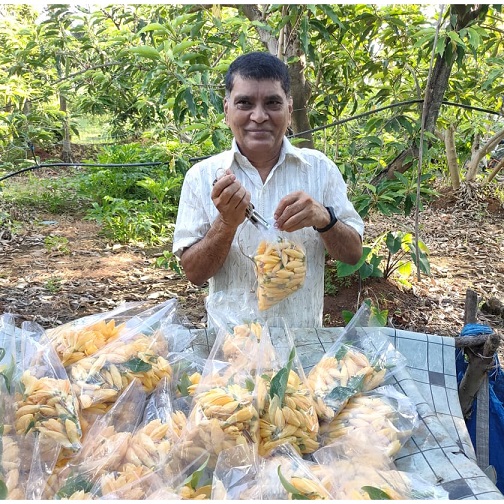Farmer Makes Rs 9 Lakh/Year Growing Mumbai’s Favourite Flower, Inspires 25 Villages
“When I introduced Sonchafa among Mogra sellers, they had neither heard of, nor seen such a flower; and so for weeks, I offered it to them for free as an incentive,” says D’Britto.

For many Mumbaikars, Sonchampa has become a favourite flower for religious rituals and daily prayers. What usually sells at Rs 100 for 100 flowers in the Dadar flower market, attracts a price of Rs 700 during the 11-day festival of Ganesh Chaturthi! The same happens during the wedding season and the Navratri festival.
It was 64-year-old flower grower Robert D’Britto who introduced Mumbai to the golden-yellow flower with a heady scent. He discontinued his studies at a polytechnic due to his father’s illness. Like many others, he had been cultivating Mogra for decades.
“The Mogra crop experienced a severe pest problem in 1998-99, and I switched to Sonchafa after studying its potential,” informs D’Britto as we meet in his wadi, which also accommodates his one-storied house. “Two decades ago, Mogra (Jasminum sambac) was oppular among worshippers to offer to their favourite deity, be it at Siddhi Vinayak or the Lalbaugcha Raja.”
But now, it’s the eleven-petalled and inverted lance-shaped Sonchafa, as Mumbaikars prefer to call the Magnolia champaka.
The search of Sonchafa saplings led D’Britto to Kudal-based Velankar Nursery from where he sourced 225 of them, planting them on a 30-guntha plot (equal to 30,000 sq ft) in Satpale village in Vasai taluka.
A medium climbing shrub of 8-10 ft, Sonchafa produces greenish flowers that fade to yellow, and are extremely fragrant. Once picked, they last long and retain their scent for days if kept in water. When young, this climber grows like a regular shrub, but starts to vine at 5-6 ft. Its irrigation needs are minimal, once in four days.
“When I introduced Mogra sellers to Sonchafa, they had neither heard of, nor seen such a flower; and so for weeks, I offered it to them for free as an incentive,” says D’Britto. “I even picked up Tamil to converse with the flower sellers. Soon, demand grew as its fragrance lasted days, unlike that of other flowers.”
Looking at the popularity of the newly-introduced flower, farmers in neighbouring villages started uprooting their Mogra bushes and planted Sonchafa.

Presently, close to 500 families grow Sonchafa in Vasai and Virar—all assisted and guided by D’Britto, a recipient of the prestigious Vasantrao Naik Agriculture Award in 2012. The award was named after the longest-serving Chief Minister of Maharashtra, and came with a cash award of Rs 25,000; it recognises farmers who have excelled by their innovative practices, use of new techniques, increase in production volumes etc.
D’Britto’s day begins early with the plucking of flowers. “Beginning my day in a fragrant garden gives me a heady feeling and a priceless experience,” says D’Britto.
Picked and packed in poly bags in batches of 100, the flowers are ready for their journey to Mumbai. On average, about 10,000-11,000 flowers leave D’Britto’s garden each day, with the bags being reused several times.
Sonchafa flowers 365 days a year, and from March to October, each shrub offers 150-200 flowers. During the winter months, flowering witnesses a slight drop. However, it is easy to grow when allowed to spread horizontally; this makes it easier to reach and pick the flowers, says D’Britto, who uses powdered cow dung to fertilise his plants.
“The workers take the 9.09 am Churchgate local from Virar and reach Dadar flower market by 10.45 am,” says D’Britto, who makes close to Rs 75,000 a month, and nearly Rs 9 lakh a year, post the expenses.
How did COVID-19 and the subsequent lockdown affect him?
In the initial fortnight of lockdown, D’Britto suffered losses as he was unable to arrange for transport to take the flowers to the market, which was 58 km away. This meant letting the flowers remain unplucked.
But, being a pioneer, he found a solution. He elaborates, “Ever since the suburban local trains stopped plying, we have been taking the flowers in our vehicle.”
Presently, over 25 villages in Vasai taluka, namely Jalodi, Agashi, Nala, Rajouri, Navapur, Motekoria and others specialise in irrigating Sonchafa plants using sprinklers.
Also Read: After 20 Years of Work, 55-YO Farmer Develops Grape Variety With 40% Higher Yield
According to Sylvester F Miranda (65), Vasai taluka has emerged as a Sonchafa floriculture hub, where growers have prospered due to the proximity of the market. He is a part-time farmer in Adla village and former Vice-Principal of Uttan-based St Joseph High School and Junior College.
For those who want to take up Sonchafa farming, D’Britto advises, “It can be grown in any soil where water doesn’t stand. But before going for planting, you need to develop a market for its flowers, and more importantly, wait two years for the plants to flower.”
(Edited by Shruti Singhal)
Like this story? Or have something to share?
Write to us: [email protected]
Connect with us on Facebook and Twitter.
If you found our stories insightful, informative, or even just enjoyable, we invite you to consider making a voluntary payment to support the work we do at The Better India. Your contribution helps us continue producing quality content that educates, inspires, and drives positive change.
Choose one of the payment options below for your contribution-
By paying for the stories you value, you directly contribute to sustaining our efforts focused on making a difference in the world. Together, let’s ensure that impactful stories continue to be told and shared, enriching lives and communities alike.
Thank you for your support. Here are some frequently asked questions you might find helpful to know why you are contributing?


This story made me
-
97
-
121
-
89
-
167











